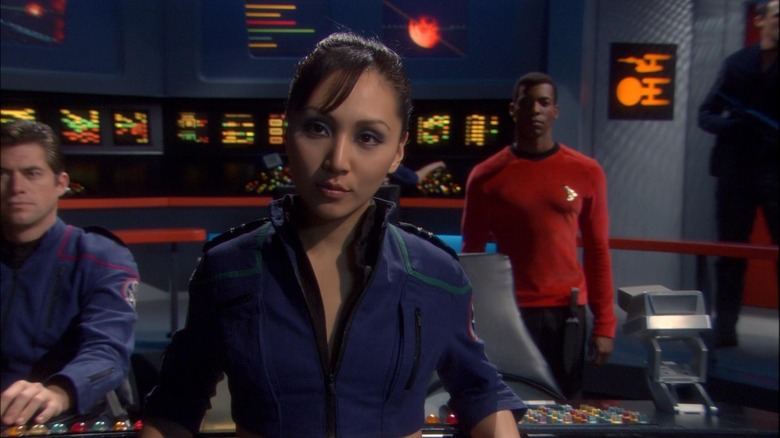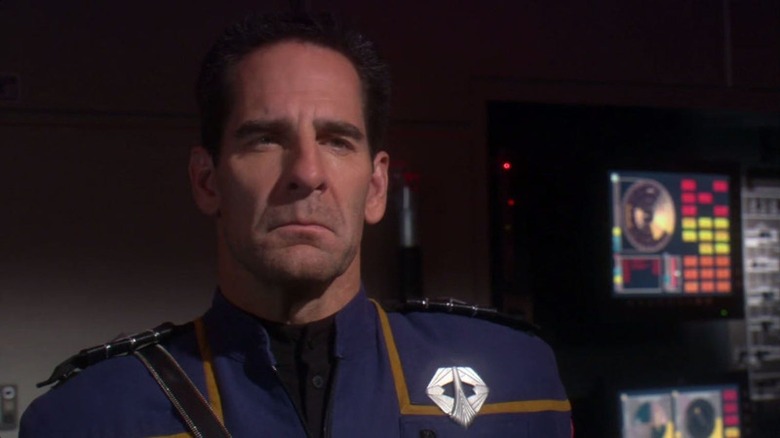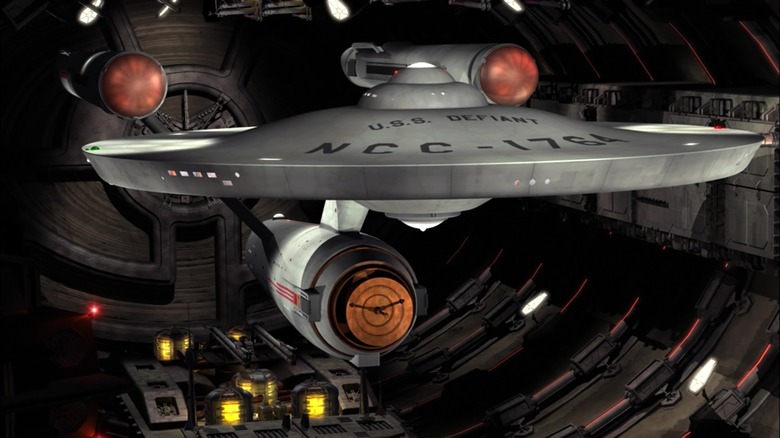The Canceled Storyline That Could Have Saved Star Trek: Enterprise
Consensus opinion among Trekkies is that the fourth season on "Star Trek: Enterprise" was right when the show was getting good. "Star Trek," previously constructed — strongly — of bottled-off hour-long morality plays, was facing a changing mid-2000s TV landscape where mainstream shows were moving away from singular, the-story-is-resolved-at-the-end-of-the-hour episodes and leaning into season- and series-long story arcs that wouldn't pay off until years down the line.
With "Enterprise," you could see the growing pains in real time. The first two seasons of "Enterprise" were more traditionally "Star Trek" in their structure, encapsulating miniature dramas or issues-of-the-week that would be completed by the end of the episode. At the beginning of season 3, however, "Enterprise" introduced a new premise for the show: Florida had been destroyed by an unknown alien weapon, and the U.S.S. Enterprise, with a new military retinue, had to seek out the perpetrators: a mysterious species called the Xindi who were, in turn, taking orders from an even more mysterious cabal of time-traveling prognosticators. While there were still bottle episodes in season 3, "Enterprise" began — however awkwardly — to skew toward multi-episode arcs, with an eventual, long-awaited payoff at the end of the season. It was clunky for the time, but it was fascinating watching "Star Trek" attempt to bridge the gap between its established decades of storytelling traditions and the newer binge-ready model. The fourth season of "Enterprise" was also about longer story arcs, incorporating several two-to-four episode miniseries within the broader scope of the show.
Despite its best efforts, "Enterprise" was canceled at the end of season four. A disappointment for a franchise whose three previous shows ran seven seasons apiece.
But there was a plan to save the show with an ambitious multiverse episode that would have seen the return of William Shatner.
In a mirror, darkly
The 18th and 19th episodes of the fourth season of "Enterprise" were a two-part story arc called "In a Mirror Darkly." The title, incidentally, is derived from the American Standard Version of 1 Corinthians 13:12, which reads: "For now we see in a mirror, darkly; but then face to face: now I know in part; but then shall I know fully even as also I was fully known."
The (clever) conceit of the episode was that the show was to suddenly change perspectives from our main characters to their counterparts in the "Star Trek" Mirror universe, where everyone was evil and the Enterprise was devoted to conquest. For the non-Trekkies, it was where Spock had a goatee.
There was, however, no organic narrative crossover between the "good" universe and the "bad" universe. Traditionally, our star characters would slip through an aperture in the space-time continuum, or use the transporters during an ion storm or something. Instead, audiences were treated, suddenly, to two episodes of what was essentially a new show, complete with a new theme song (gone was the terrible Russell Watson song that Rod Stewart composed for "Patch Adams") and a new title sequence; In the original title sequence, we saw the evolution of human travel, from the earliest sailing ships, through the first airplanes, space shuttles, and finally the Enterprise itself. It's been a long road getting from there to here. In the new title sequence, the ships were depicted as ships of war and the Enterprise was seen firing weapons and overthrowing alien worlds. Some of the footage was taken from the 1996 film "Star Trek: First Contact," and some from the 1990 submarine thriller "The Hunt for Red October."
Additionally, the crew was seen wearing evil new uniforms (exposed biceps for men, exposed midriffs for women), had an evil doctor, and was generally just evil.
When we caught up with the action, we met Jonathan Archer (Scott Bakula) serving as the evil first officer on the evil I.S.S. Enterprise (the "I" is for "imperial"), working evilly under the evil Capt. Forrest (Vaughn Armstrong). Every single character has a scheme to assassinate or overthrow their immediate superiors. The plot involved the Enterprise NX-01 investigating the mysterious, sudden appearance of a Kirk-era ship — the U.S.S. Defiant — from the "good" universe. The U.S.S. Defiant will be known by Trekkies as the ship the U.S.S. Enterprise NCC-1701 was attempting to rescue from a strange spatial phenomenon in the original series episode "The Tholian Web." In that episode, the Defiant eventually vanished into another dimension. As it turns out, it would turn up in the Mirror Universe, and about a century in the past. The Mirror Enterprise NX-01 sought the ship because of its a-century-in-advance technology, intending to use it as an instrument of conquest, with Commander Archer eventually wanting to conquer Earth itself and install himself as emperor.
Shatner's return
Oops! At the last minute, Evil Archer is betrayed by Evil Hoshi Sato (Linda Park), and she is installed as empress instead. This Trekkie was a mite miffed that, when the Mirror Universe was eventually re-visited on "Star Trek: Discovery" years later, that Empress Sato was no longer on the throne.
The ambitions for the episode were high, and the two-parter is immensely entertaining — Tholians! Gorn! — but there was a plan to make it even more eye-catching with the inclusion of Captain Kirk himself, played by William Shatner. Executive producer and fourth-season showrunner Manny Coto gave an interview in 2014 with StarTrek.com explaining that Shatner was not only intended to participate, but was actually interested in participating. This would have been a great return for Shatner, whose famed character died at the end of 1994's "Star Trek: Generations." It was unclear what role he would have played in the story, but his participation would certainly have been enough to garner attention from the public at large.
At least that's what Coto thought. Coto seems to have known the writing was on the wall about the cancelation of "Enterprise," as he explains that this casting gimmick was a bit of a last-ditch effort to gain the attention of Paramount's higher-ups, and earn just enough approval to lead into a fifth season. Sadly, the gimmick didn't work, as Paramount was unwilling to pay Shatner's fee. The show was already flagging, so a larger budget to cover what was clearly a stunt wasn't in Paramount's interests.
Coto also explains in the same interview that the fifth season of "Enterprise" was already poised to tackle a few notable, exciting story possibilities. There was going to be a deeper look into the Romulan Conflict, so often referenced throughout the franchise's history. Coto also wanted to revisit the city of Stratos from the original series episode "The Cloud Minders," and start linking "Enterprise" to more establish Trek lore at large.
But it was not to be. Ratings continued to sink, and the show ended its run in May of 2005. Could Shatner's participation have worked to save the show? I suppose we'd have to visit the Mirror Universe to find out.


